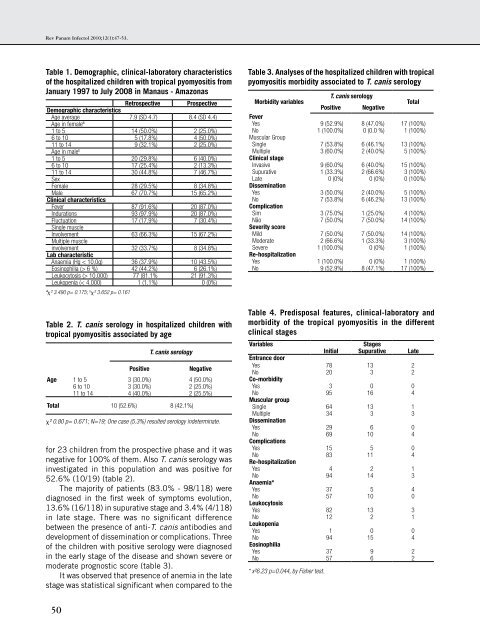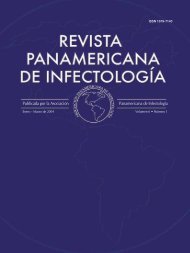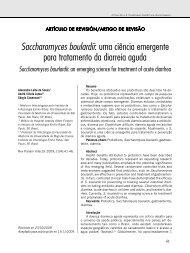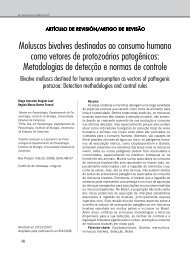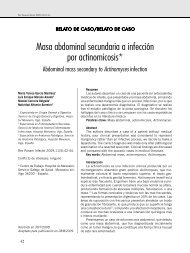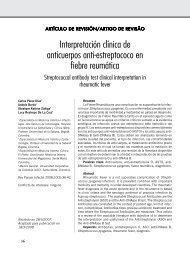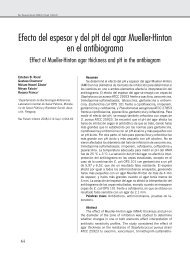Clinical-laboratorial characteristics Toxocara canis serology and ...
Clinical-laboratorial characteristics Toxocara canis serology and ...
Clinical-laboratorial characteristics Toxocara canis serology and ...
Create successful ePaper yourself
Turn your PDF publications into a flip-book with our unique Google optimized e-Paper software.
Rev Panam Infectol 2010;12(1):47-53.<br />
Table 1. Demographic, clinical-laboratory <strong>characteristics</strong><br />
of the hospitalized children with tropical pyomyositis from<br />
January 1997 to July 2008 in Manaus - Amazonas<br />
Retrospective Prospective<br />
Demographic <strong>characteristics</strong><br />
Age average<br />
Age in femaleª<br />
7.9 (SD 4.7) 8.4 (SD 4.4)<br />
1 to 5 14 (50.0%) 2 (25.0%)<br />
6 to 10 5 (17.8%) 4 (50.0%)<br />
11 to 14<br />
Age in male<br />
9 (32.1%) 2 (25.0%)<br />
b<br />
1 to 5 20 (29.8%) 6 (40.0%)<br />
6 to 10 17 (25.4%) 2 (13.3%)<br />
11 to 14<br />
Sex<br />
30 (44.8%) 7 (46.7%)<br />
Female 28 (29.5%) 8 (34.8%)<br />
Male<br />
<strong>Clinical</strong> <strong>characteristics</strong><br />
67 (70.7%) 15 (65.2%)<br />
Fever 87 (91.6%) 20 (87.0%)<br />
Indurations 93 (97.9%) 20 (87.0%)<br />
Fluctuation<br />
Single muscle<br />
17 (17.9%) 7 (30.4%)<br />
Involvement<br />
Multiple muscle<br />
63 (66.3%) 15 (67.2%)<br />
involvement<br />
Lab characteristic<br />
32 (33.7%) 8 (34.8%)<br />
Anaemia (Hg < 10,0g) 36 (37.9%) 10 (43.5%)<br />
Eosinophilia (> 6 %) 42 (44.2%) 6 (26.1%)<br />
Leukocytosis (> 10.000) 77 (81.1% 21 (91.3%)<br />
Leukopenia (< 4.000) 1 (1.1%) 0 (0%)<br />
ªx² 3.490 p= 0.175; bx² 3.652 p= 0.161<br />
Table 2. T. <strong>canis</strong> <strong>serology</strong> in hospitalized children with<br />
tropical pyomyositis associated by age<br />
50<br />
T. <strong>canis</strong> <strong>serology</strong><br />
Positive Negative<br />
Age 1 to 5 3 (30.0%) 4 (50.0%)<br />
6 to 10 3 (30.0%) 2 (25.0%)<br />
11 to 14 4 (40.0%) 2 (25.5%)<br />
Total 10 (52.6%) 8 (42.1%)<br />
x² 0.80 p= 0.671; N=19; One case (5.3%) resulted <strong>serology</strong> indeterminate.<br />
for 23 children from the prospective phase <strong>and</strong> it was<br />
negative for 100% of them. Also T. <strong>canis</strong> <strong>serology</strong> was<br />
investigated in this population <strong>and</strong> was positive for<br />
52.6% (10/19) (table 2).<br />
The majority of patients (83.0% - 98/118) were<br />
diagnosed in the first week of symptoms evolution,<br />
13.6% (16/118) in supurative stage <strong>and</strong> 3.4% (4/118)<br />
in late stage. There was no significant difference<br />
between the presence of anti-T. <strong>canis</strong> antibodies <strong>and</strong><br />
development of dissemination or complications. Three<br />
of the children with positive <strong>serology</strong> were diagnosed<br />
in the early stage of the disease <strong>and</strong> shown severe or<br />
moderate prognostic score (table 3).<br />
It was observed that presence of anemia in the late<br />
stage was statistical significant when compared to the<br />
Table 3. Analyses of the hospitalized children with tropical<br />
pyomyositis morbidity associated to T. <strong>canis</strong> <strong>serology</strong><br />
T. <strong>canis</strong> <strong>serology</strong><br />
Morbidity variables<br />
Fever<br />
Positive Negative<br />
Total<br />
Yes 9 (52.9%) 8 (47.0%) 17 (100%)<br />
No<br />
Muscular Group<br />
1 (100.0%) 0 (0.0 %) 1 (100%)<br />
Single 7 (53.8%) 6 (46.1%) 13 (100%)<br />
Multiple<br />
<strong>Clinical</strong> stage<br />
3 (60.0%) 2 (40.0%) 5 (100%)<br />
Invasive 9 (60.0%) 6 (40.0%) 15 (100%)<br />
Supurative 1 (33.3%) 2 (66.6%) 3 (100%)<br />
Late<br />
Dissemination<br />
0 (0%) 0 (0%) 0 (100%)<br />
Yes 3 (50.0%) 2 (40.0%) 5 (100%)<br />
No<br />
Complication<br />
7 (53.8%) 6 (46.2%) 13 (100%)<br />
Sim 3 (75.0%) 1 (25.0%) 4 (100%)<br />
Não<br />
Severity score<br />
7 (50.0%) 7 (50.0%) 14 (100%)<br />
Mild 7 (50.0%) 7 (50.0%) 14 (100%)<br />
Moderate 2 (66.6%) 1 (33.3%) 3 (100%)<br />
Severe<br />
Re-hospitalization<br />
1 (100.0%) 0 (0%) 1 (100%)<br />
Yes 1 (100.0%) 0 (0%) 1 (100%)<br />
No 9 (52.9%) 8 (47.1%) 17 (100%)<br />
Table 4. Predisposal features, clinical-laboratory <strong>and</strong><br />
morbidity of the tropical pyomyositis in the different<br />
clinical stages<br />
Variables Stages<br />
Initial Supurative Late<br />
Entrance door<br />
Yes 78 13 2<br />
No<br />
Co-morbidity<br />
20 3 2<br />
Yes 3 0 0<br />
No<br />
Muscular group<br />
95 16 4<br />
Single 64 13 1<br />
Multiple<br />
Dissemination<br />
34 3 3<br />
Yes 29 6 0<br />
No<br />
Complications<br />
69 10 4<br />
Yes 15 5 0<br />
No<br />
Re-hospitalization<br />
83 11 4<br />
Yes 4 2 1<br />
No<br />
Anaemia*<br />
94 14 3<br />
Yes 37 5 4<br />
No<br />
Leukocytosis<br />
57 10 0<br />
Yes 82 13 3<br />
No<br />
Leukopenia<br />
12 2 1<br />
Yes 1 0 0<br />
No<br />
Eosinophilia<br />
94 15 4<br />
Yes 37 9 2<br />
No 57 6 2<br />
* x²6.23 p=0.044, by Fisher test.


